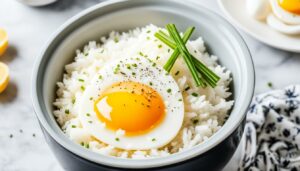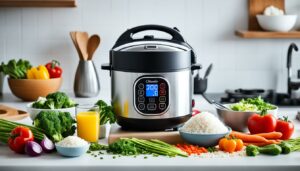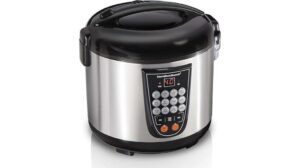Are you a busy mom who likes to whip up quick and easy pastas for your family? Or maybe you’re trying to make the perfect al dente dish in your rice cooker? Whether you are an experienced home cook or just starting out, one thing is certain; cooking pasta requires the right water-to-pasta ratio! Instead of guesswork or trial and error, this blog post will provide all mothers with the essential information needed to achieve mouthwatering results every single time. Learn the secrets behind getting perfectly cooked pasta with this foolproof trick and never have soggy or undercooked meals again!
Table of Contents
What is the Ideal Water-to-Pasta Ratio for Rice Cookers
When it comes to cooking pasta in a rice cooker, determining the ideal water-to-pasta ratio can be a bit tricky.
Generally, the rule of thumb is to use about two cups of water for every cup of pasta.
However, this ratio can vary depending on the type and brand of rice cooker you’re using, as well as the type of pasta you’re cooking. It’s always a good idea to consult your rice cooker’s user manual to find out the manufacturer’s recommended water-to-pasta ratio.
- 8 ounces of pasta (about 4 servings) requires 4-6 cups of water.
- For smaller amounts of pasta (1-2 servings), use a smaller pot and adjust the amount of water accordingly.
- Salt the water with about 1-2 teaspoons of salt per quart of water.
- Cook the pasta uncovered, stirring occasionally, until it is al dente, which means tender but still slightly firm to the bite. This usually takes 8-12 minutes depending on the type and shape of the pasta.
Another helpful tip is to start with a little less water than you think you need, and add more as necessary. With a little experimentation, you’ll soon be cooking perfect pasta in your rice cooker every time!
Tips for Accurately Measuring Water and Pasta
When it comes to cooking pasta, getting the water-to-pasta ratio just right is essential for a successful dish. But, if you’re trying this for the first time then measuring out the perfect amount of water and pasta can be tricky.
One tip for accurate water measurements is to use a liquid measuring cup instead of a regular cup, as it will provide a more precise measurement. Additionally, it’s important to ensure the water is boiling before adding the pasta to ensure even cooking. For accurately measuring pasta, experts recommend using a kitchen scale, as different types of pasta have varying weights and measuring by volume can result in inconsistent portions. By following these tips, you can cook up a delicious bowl of pasta with confidence.
What to Do if Your Pasta Comes Out Too Soggy or Undercooked
Cooking pasta can be a little tricky. If you’re not careful, it can either end up too soggy or undercooked. But don’t worry, there are ways to fix it.
If your pasta is too soggy, try draining it and giving it a quick rinse in cold water to stop the cooking process.
After that, try tossing it in a light sauce and allowing it to cook for a few more minutes. On the other hand, if your pasta is undercooked, simply continue cooking it in boiling water for a few more minutes until it reaches your desired texture.
Remember to taste test it regularly to avoid overcooking! By following these simple steps, you can salvage your pasta and enjoy a delicious meal.
Pros and Cons of Cooking Rice and Pasta Together in a Rice Cooker
Rice and pasta are two staple grains that are commonly included in daily meals. However, cooking them separately can take up a lot of time and effort. Cooking them together in a rice cooker may seem like a convenient solution, but it comes with both pros and cons.
On the one hand, combining rice and pasta in a single pot saves both cooking time and energy. Additionally, the starch released from the pasta can help the rice cook more evenly, resulting in a dish with perfect texture.
On the other hand, cooking the two grains together may result in a dish that lacks flavor and tastes bland.
As well as this, the cooking times for the two ingredients may vary, which could lead to either undercooked or overcooked pasta or rice. Ultimately, whether cooking rice and pasta together is a good idea depends on your personal preference and cooking skills.
Our Favorite Rice Cooker Recipes with Perfectly Cooked Pasta
Rice cookers are versatile kitchen appliances that can also be used to cook perfect pasta dishes with minimal effort.
One of our favorite rice cooker pasta recipes is creamy mushroom pasta. Simply sauté mushrooms and garlic in butter, add uncooked pasta, broth, cream, and parmesan cheese to the rice cooker, and let it cook automatically.
Another favorite recipe is shrimp scampi pasta, which involves cooking garlic, red pepper flakes, and shrimp in olive oil in the rice cooker before adding in cooked pasta, lemon juice, and parsley. With a rice cooker, you can easily prepare delicious and satisfying pasta dishes without having to constantly monitor the stove.
You can find more pasta recipes that you can cook in your rice cooker right here.
How to Clean Your Rice Cooker After Making Perfectly Cooked Pasta Every Time
Keeping your rice cooker clean might seem like a daunting task after making your favorite pasta dish, but it doesn’t have to be. Follow these simple steps to keep your appliance sparkling clean for months to come.
First, unplug the cooker and let it cool down. After that, you can remove the inner pot and wash it with warm soapy water. It’s essential to avoid abrasive scrubbers or harsh chemicals to prevent damaging the non-stick coating.
Next, give the lid a thorough wipe with a damp cloth, paying particular attention to the crevices.
Finally, wipe down the exterior of the cooker with a damp cloth and dry it with a clean towel. Voila! Your rice cooker is now sparkling clean and ready for your next culinary adventure.
By following these simple steps and references, you can master the perfect water-to-pasta ratio in your rice cooker and make delicious, perfectly cooked pasta dishes every time. With a little practice, you’ll have no need to worry about soggy or undercooked pasta anymore. Beyond that, cooking rice and pasta together in the same pot with a rice cooker has its own unique set of pros and cons which you should be aware of. No matter how you choose to cook your favorite grains, always remember to clean up afterwards for top performance! We hope this guide provided all the help you need to discover the best water-to-pasta ratio for your needs as well as enjoy some tasty recipes along the way. Thanks for joining us; happy cooking!






